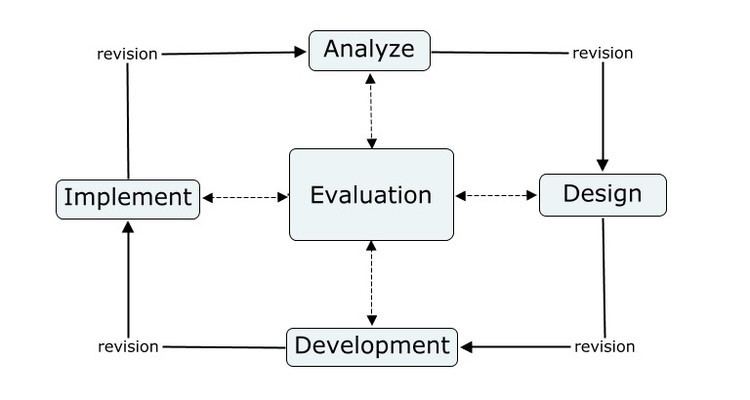 | ||
The ADDIE model is a framework that lists generic processes that instructional designers and training developers use. It represents a descriptive guideline for building effective training and performance support tools in five phases.
Contents
- History
- Analysis phase
- Design phase
- Development phase
- Implementation phase
- Evaluation phase
- Other versions
- References
ADDIE is an Instructional Systems Design (ISD) framework. Most current ISD models are variations of the ADDIE process. Other models include the Dick & Carey and Kemp ISD models. Rapid prototyping is a commonly used alternative to this approach; rapid prototyping is the idea of reviewing continual or formative feedback while creating instructional materials. This model strives to save time and money by catching problems while they are still easy to fix. A more recent expression of rapid prototyping is SAM (successive approximation model).
Instructional theories also play an important role in the design of instructional materials. Theories such as behaviorism, constructivism, social learning, and cognitivism help shape and define the outcome of instructional materials.
History
Florida State University initially developed the ADDIE framework to explain, “...the processes involved in the formulation of an instructional systems development (ISD) program for military interservice training that will adequately train individuals to do a particular job and which can also be applied to any interservice curriculum development activity.” The model originally contained several steps under its five original phases (analyze, design, develop, implement, and evaluate). The idea was to complete each phase before moving to the next. Over the years, practitioners revised the steps, and eventually the model became more dynamic and interactive than the original hierarchical version. By the mid-1980s, the version familiar today appeared.
Analysis phase
The analysis phase clarifies the instructional problems and objectives, and identifies the learning environment and learner's existing knowledge and skills. Questions the analysis phase addresses include:
Design phase
The design phase deals with learning objectives, assessment instruments, exercises, content, subject matter analysis, lesson planning, and media selection. The design phase should be systematic and specific. Systematic means a logical, orderly method of identifying, developing and evaluating a set of planned strategies targeted for attaining the project's goals. Specific means each element of the instructional design plan must be executed with attention to details.
Development phase
In the development phase, instructional designers and developers create and assemble content assets blueprinted in the design phase. In this phase, the designers create storyboards and graphics. If e-learning is involved, programmers develop or integrate technologies. Testers debug materials and procedures. The project is reviewed and revised according to feedback.
Implementation phase
The implementation phase develops procedures for training facilitators and learners. Training facilitators cover the course curriculum, learning outcomes, method of delivery, and testing procedures. Preparation for learners includes training them on new tools (software or hardware) and student registration. Implementation includes evaluation of the design.
Evaluation phase
The evaluation phase consists of two aspects: formative and summative. Formative evaluation is present in each stage of the ADDIE process, while summative evaluation is conducted on finished instructional programs or products.
Other versions
Some institutions have modified the ADDIE model for their needs. One version of note is the United States Navy version. It is called PADDIE+M. The P phase is the planning phase. In this phase, the project goals, project objectives, budget, and schedules are developed. The M phase is the Maintenance phase. This phase involves the life cycle maintenance of the training product using continuous improvement methods. This model is gaining acceptance in the United States government as a more complete model of ADDIE. Some organizations have adopted the PADDIE model without the M phase. Pavlis Korres (2010), in her instructional model (ESG Framework), has proposed an expanded version of ADDIE, named ADDIE+M, were Μ=Maintenance of the Learning Community Network after the end of a course. The Maintenance of the Learning Community Network is a modern educational process which supports the continuous educational development of its members, by using social media and web tools.
